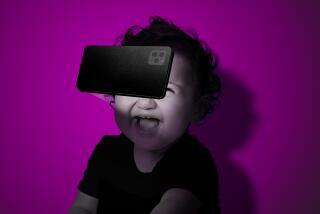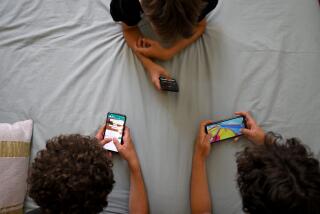Young kids sleep better when you change their media diet

- Share via
What your kids watch on TV can affect how well they sleep, a new study suggests.
Published in the journal Pediatrics, the study found that when parents intervened in their kids’ media diet -- reducing exposure to violent and age-inappropriate content and replacing it with age-appropriate, educational and empathy-building content such as “Curious George,””Sesame Street” and “Dora the Explorer” -- the children had fewer sleep problems, less aggression, and increased empathetic and friendly behaviors.
Child sleep problems include difficulty falling asleep, night wakings, nightmares, difficulty waking and daytime tiredness. All have been linked to higher rates of injuries, behavioral and emotional problems, obesity and difficulties in school later on.
“A lot of studies are focused on tailoring the amount of TV [children watch] or trying to get people to stop altogether,” said Michele Garrison of Seattle Children’s Research Institute, lead author of the new study.
She and her colleagues took a different tack. “We looked to have parents make a more feasible change -- switching to more age-appropriate content,” she said.
The study, which was funded by the National Institute of Child Health and Human Development, involved 565 children of ages 3 to 5 from the Seattle metropolitan area over a period of 18 months, and their families.
Some of the parents -- the control group -- were simply told that they were participating in a nutrition intervention study aimed at decreasing consumption of sugary drinks. They were not given any instructions to change the media to which their children were exposed.
Other parents -- the intervention group -- were told to replace age-inappropriate media with educational and nonviolent content. They were to monitor kids’ television, DVDs, computers, video games and hand-held devices.
Overall exposure to media was not reduced among the intervention group, just the type of media. Parents were also encouraged to watch programs with their children to increase their own awareness of what the children were watching.
“We suggested age-appropriate shows for the entire spectrum for 3- to 5-year-olds, but we also told parents it is important to pay attention to how your child reacts to a show. A shows that is a good fit for one 4-year-old can be bad another 4-year-old, who might find it scary,” Garrison said.
Case managers of the study gave participating families an initial home visit, then performed monthly follow-up telephone calls for 12 months. During this period, the families also received monthly mailings that included a program guide with recommended television shows and a newsletter with advice for making sure their kids watched those programs. Parents recorded their kids’ sleeping habits throughout the study, filling out a Child Sleep Habits Questionnaire for the researchers.
After 12 months, the intervention was stopped (although the parents continued to record their kids’ sleep patterns for six more months). At that point, the children in the intervention group had a 64% lower rate of reported sleep problems.
“Children with sleep problems were more likely to improve, and if they didn’t have sleep problems, the children were less likely to develop them over time,” Garrison said.
But when the intervention ended, the effects began to erode: Six months later, the effects of media intervention had decreased, although not to baseline levels. This shows that families may need continued support in limiting their children’s media exposure to educational and empathy-promoting programs, the authors said.
The most common sleep problem among the children in the study was delay in falling asleep. In all, 26% of the children took longer than 20 minutes to fall asleep for two to four nights a week. There was no significant association of sleep problems with behavior problems, gender or low-income status.
“Going into this, we thought maybe we would see a bigger effect in low-income households,” Garrison said. “What was interesting here was that across the entire socioeconomic spectrum, everybody had room for improvement. Families had a decent understanding that watching the latest ‘Transformer’ movie wasn’t the best choice for a 3-year-old, [but] even high-income families didn’t get that even children’s cartoons could still be too much for a 3- or 4-year-old. That was new information for everyone.”






